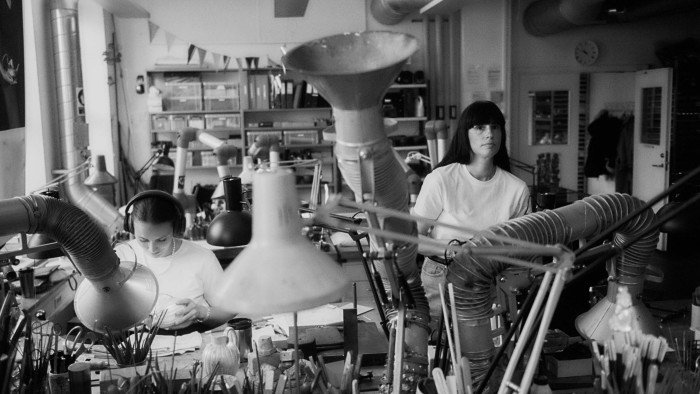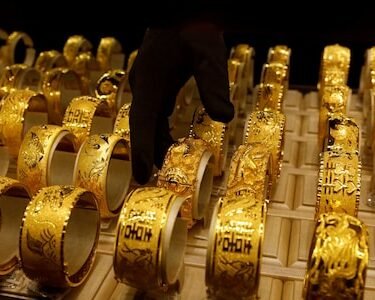It’s early summer in the Georg Jensen workshop in Copenhagen, and the young apprentices and masters – all known as smithies – are at work. It is here, in a lofty warehouse space that has been the company’s headquarters since 2004, that all of the handmade and bespoke items are beaten, polished and hand-carved.
Melanie Larsen, an apprentice, is working on a silver cup, her iteration of a project with which students are presented in their first trial weeks. Her second attempt at making a perfect vessel, her work is already accomplished, symmetrical and neat.

Christian Arndt Armbrecht is working on a set of silver medals. Georg Jensen has a royal warrant and makes the orders and medals with which Danish citizens are honoured: these medals are imprinted with the likeness of King Frederik X, who was crowned last year. Timur Muharemovic is making a cigarette case – considered a technical milestone in the apprentice’s journey despite its obsolescence in the real world. He was formerly a catwalk model. Well, we are in Denmark after all.
Georg Jensen was founded in 1904 by the Danish designer and entrepreneur of the same name. He started the business from a cabinet of silverware in Copenhagen’s city centre and was its creative director until his death in 1935, having made the brand famous throughout the world. Following different ownerships, it was acquired in 2023 by Fiskars – the Finnish group that owns the brand behind the orange-handled scissors – for €151mn. (In 2022 it declared revenues of DKr1.2bn, about £130mn, a six per cent growth on the previous year.) Georg Jensen joined an illustrious design stable; Fiskars also owns the Danish porcelain maker Royal Copenhagen and Wedgwood, the fine bone china company. But while the brand has the lustre of an important heritage, it has suffered from a certain blandness and product saturation in recent years.


“We acquired the brand because of our conviction in its potential as Denmark’s definitive luxury house,” says Jacob Siboni, the senior vice president since 2023. “[It has] a potential much greater than its current reach.” Future plans include “new ranges of products and a return to categories that reflect the richness of our history. In parallel, we are aiming to expand our distribution footprint, including the opening of new retail stores.”
In charge of this design focus is Paula Gerbase, the Brazilian designer appointed creative director in 2024. A multidisciplinary creative, she arrived last September having worked previously on her own tailoring, clothing and jewellery labels, as well as at Sunspel and at the Hermès-owned shoemaker John Lobb. “With a background in craft through her training on Savile Row, Paula was the obvious choice,” says Siboni. “She’s someone who can appreciate the breadth of Georg Jensen’s artistic expression, looking beyond its current brand image and product lines. She is an innovator who is an uncompromising guardian of quality and a champion of design.”

Gerbase is not a smithy. Her apprenticeship lasted only about six days. Her attempt at a cup now sits, wonky and abandoned, on a counter in the workshop, a sweet reminder that she still has much to learn. Nevertheless, she has fallen hard for silver (and gold, an important but less conspicuous feature of the house). Moreover, she wants to test Georg Jensen’s reputation as a maker of minimalist things. “When I arrived, I thought I was taking over a lovely Danish brand that had a kind of minimalist expression with some art nouveau pieces in its heritage,” she says. “But what has unfolded is that this brand is not a brand, it’s a house, and it was a luxury house from 1904 until 1979.”
Silver has enjoyed a mixed popularity in recent years, but since Covid-19 a new generation is popularising it again. “In terms of investment, obviously the recent rise of the price of silver (and gold) has generated some interest from clients,” says Isabelle Cartier-Stone, silver specialist at Christie’s. When asked about Georg Jensen, she points to the “period 1904-1925 or ‘the Pregnant Duck’” as being the pieces of most interest. Also known colloquially as “the Swan”, the Henning Koppel Pitcher 1052 was first designed in 1952. It is made in the Copenhagen workshop from two identical flat pieces of silver that are raised and then hammered to make smooth. The Swan is iconic, beautiful to look at, and costs £28,000. However, it sits at the apex of a vast proliferation of cheaper versions, including one in electric-blue stainless steel, priced at £210.

Gerbase wants to prove the brand “can still be expansive” while “remaining pure”. Her role is to elevate the offering – and protect the core. “I feel like Scandinavian design just got completely ambushed at some point. It became synonymous with beige. Until 1970, there was a CEO who had been a maverick thinker. And then, with his retirement – mixed with the ’80s and people becoming enamoured with the idea of serialisation and mass production – the brand became known for one specific thing. So the first step for me is really about re-establishing what this house is, to speak about what the designers were doing throughout its history and, of course, doing something new.”
On a moodboard on one wall of her office sits an assortment of images: a series of silver teapots, vintage bangles and pictures from the interiors of the 1950s New York store. Gerbase is currently interested in the brand’s art nouveau era – “the very beginning, 1904 to 1915”. But she is also enamoured of the midcentury experiments she has found in the archive, located in the eaves of the headquarters: a trove of objets, sketches, prototypes and “lost” designs. Here you can find the original catalogues for Jensen’s jewellery, pieces of sculpture, lipstick holders and funky sunglasses with silver star-burst frames. “When you see a brand that is quite pure,” she says, “you can overlook its range.”


In keeping with this ethos, Gerbase’s first offering was a series of bag charms, each drawn from different eras at the house. These included the art nouveau Bud motif by Jensen, first created in 1904; the Oak, originally designed by Danish silversmith Harald Nielsen and the Facet, a rounded stud by Kim Naver, the 84-year-old Danish textile turned jewellery designer whose first collection for Georg Jensen appeared in 1973. Artists rarely had contracts that stipulated deliverables, says Gerbase, but were instead invited in to “play”. The freestyle mood is something she would like to reinvigorate, although she’s keen to nurture the spirit within the workshop rather than via talents from outside.
This spring, in a viral re-entry to the design world, Gerbase took an ice-cream store to Salone del Mobile in Milan: guests at Gelateria Danese were served cardamom-infused gelato in silver “paper” cups with tiny silver spoons. Of the 105 spoons delivered to the design fair, some 25 went missing. “In fact, hardly any were stolen,” Gerbase says. “It was more that people would forget that they were silver and throw them in the bin.”

Her next act, The Collector, is a curation of high jewellery that will also showcase the artistic traditions of the house. A magnifying glass pendant and chain are recrafted replicas of pieces by the legendary silversmith Vivianna Torun Bülow-Hübe, known as Torun. A stone-encrusted bangle is a reissue of a Nanna Ditzel design, based on a very rudimentary prototype found in the archive.
The collection of reissued pieces could be described as couture, but it’s a word that Gerbase resists. “Georg Jensen always wanted his pieces to be of high quality but he would have never called himself a jeweller or a maker of high jewellery. It’s also why he did not use diamonds or sapphires; he was naturally drawn to far less precious stones. Plus, it’s silver – even though he worked with gold, silver was his preference. And I think that there’s a real beauty in the way he saw beyond what is meant by high jewellery or fine.”
Today, there are between 23 and 26 employees in the workshop; a further 13 people work in Gerbase’s own creative team. Bespoke pieces are still handmade in Copenhagen but most of the industrial production is elsewhere. The main jewellery line is made in Thailand, says Gerbase, “because they have better tools”. Glassware is often made in Portugal. Slovakia mainly does the wood. “It’s really [about] where the specialism is,” says Gerbase, “rather than saying we only produce in X,Y, Z.”


Back in the workshop we meet Stella Birkefeldt, a fourth-generation silversmith who now works on the bench alongside her father, Michael, a master silversmith and wood carver. What’s it like to work with far? “I love it, actually,” says Stella, an apple-cheeked twentysomething who looks like an advert for the wholesome smithy life.
Across the room, Adnan Hadzihasanovic, the master cutlery-smith, works on a set of Blossom spoons – he estimates that he has made some 25,000 in his career. Opposite him is Beatriz Santos, a young chaser working with malleable metal: she shares a book in which she has made exquisitely handwritten notes.

Michael also has a smaller private workshop, in which sits a Pyramid coffee pot held together with a wooden vice. First designed in 1930, the pot is part of the art deco offering, with sweeping curves, geometric contours and a handle in darkest ebony. The shiny metal adds another touch of magic to a room that feels like something in a Hans Christian Andersen fairytale – the workstation is arranged with hundreds of utensils, each tool handmade by every worker to meet their individual needs.
Next door, in the hammering room, a drawing of “the Pregnant Duck” is taped to a locker stacked with hammers and other tools. If Gerbase’s plan comes to fruition, this long-standing hero of the workshop is poised to sit within a broader portfolio. It’s easy to see why she’s become so passionate about this atelier and the change she hopes to bring. Thanks to the less-known treasures hiding in the archive, the duck should become just one of many icons allowed to soar.






